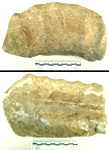Ammonite

Click ^ for larger image.
This part of the coil of a large ammonite (originally at least 0.5m in diameter) shows the radial ridges that ran around the coils, and also part of the internal shell structure (the straight lines on the underside of the fossil). It did not come from Brislington but was brought here by human hands, almost certainly from Keynsham, probably in the 18th century when it was fashionable for the large, estate houses to exhibit nature's curiosities. It is this human intervention that makes this piece of geology of interest to archaeologists.
The market town of Keynsham, just 4km (2.5 miles) southeast of Brislington, is well-known for its ammonites that swam there in the Lower Jurassic period, at least 175 million years ago. Many specimens are embedded in garden walls there, and examples are even enshrined in the exterior wall of the parish church (recalling, perhaps, the medieval legend of St Keyna who reputedly petrified the local serpent population, and gave the town her name).
Material: stone
Period: Post Medieval
Find spot: Hampstead Road, Brislington, Bristol. ST 612710
Exhibit contributed by Ken Taylor
Text written by Ken Taylor, in 2011
Photographer: Ken Taylor
Acquisition number: 110618a3